Z6QCQ6 Code of Rituals
a story about rituals and connectedness – written, directed, video and sound by bello benischauer
ABOUT THE PIECE: The king has died. The law demands that Troja the queen needs to be sacrificed to the gods. Movement, dance, dramatic enactment, video and sound, poignant and engaging. A timeley reflection on how people connect and share their feelings.
THE STORY: The sacrifice begins. With her last words Troja tries to urge her daughter to obey the rules of the state. As soon as Syra the oracle has performed her ritual, Atusa the beautiful intervenes and brings Troja back to life. People are frightened. They fear that the gods will rage, so the women walk Troja down to the river to wash and anoint her body. Then they celebrate. But an accident happens and Troja cannot be saved this time. The people mourn their queen, even Atusa, the king’s sister and Zora, the second queen are shaken. Their tears flood the land and destroy everything familiar. The kingdom awakens out of the dark into a new time, in which desire and jealousy determine everyday life. Troja lives on as a symbol, as an icon of a bygone era. More years pass. Finally people have learned to enjoy life again. Everyone is invited to join a grand wedding. Will Troja’s wish come true and her people finally unite in love?
CONTEXT: Known for their confronting and brutally honest explorations, Existence Theatre’s newest work presents a poetic narrative that depicts archetypal characters, who meet in a fabulous story about power, trust, grief, jealousy, surrender and love.
Z6QCQ6 Code of Rituals has been written, directed and produced by Existence Theatre. It is a timely reflection on recent events and how the pandemic has interfered with people’s lives. However, these changes also activated people’s motivation to initiate new forms of bonding. The artists respond to that by delivering a hopeful outlook for human existence, emphasising the positive impact that self-actualisation can have to achieve connectedness with others in unpredictable times.
Performances: Wednesday, 22. Sep | Thursday, 23. Sep | Friday, 24. Sep | Saturday, 25. Sep – 8:00pm
ARTICLES: Stage Whispers | xpressmag
Venues: Victoria Hall, 179 High Street, Fremantle | 18+ Bar and doors open from 7:30pm | duration: approx. 85 min – no interval
performers: Emma Benischauer, Elisabeth Eitelberger, Rina Fadzlina, Sarah Healy, Daniela O’Mara, Sophie Regnier, Gala Shevtsov
ART IN PROCESS | EXISTENCE THEATRE PRODUCTION 2021
INTRODUCTION
Piece in seven images. The narrative is delivered through poetic and philosophical monologues performed by the various characters.
The Images: Sacrifical Altar – Ablution – Celebration & Feast – Funeral – Flooding – Love and Jealousy – Wedding
The Characters: TROJA (Queen) – INKA (King‘s Daughter) – SYRA (Oracle) – ZORA (2nd Queen) – ARTURA (King‘s Sister) – ATUSA (The Beautiful) – various SERVANTS
THE STORYLINE: The King has died! And the ruling system of the kingdom begins to crumble. Progressive forces seem to exist on the fringes of this country’s society. Gender and cultural diversity conflicts start to arise violently from the bottom of a collective soul that has been manipulated and dominated by masculine stereotypes over past centuries. The qualities of femininity, personified through Queen Troja, emerge in all their glory. However, Troja’s ongoing internal conflict with human existence makes her an easy target to mislead her trust. She is hated and avoided by certain people at her side, who envy her position and strength. Troja survives her sacrifice to the gods, dies, gets reborn and dies again. She rises from her grave as a spiritual guide for those struggling with heteronormatively defined femininity and is feared by those who have remained loyal supporters of patriarchy. In the end Troja lives on as an iconic figure that cannot be weakened anymore.
CONCEPT:
Dance first. Think later. It‘s the natural order. (Samuel Beckett)
PROCESS: Various performers dive into a self-sensing and self-moving exploration, with which they bring emotions and their physical limitations to the surface. While exploring their cultural identities through performed self-narratives, they build a relationship with each other that is grounded in the uniqueness of each participating performer. The more they interact, the more they ‘become’ in their multi-layered communication with each other. As their self-identities grow from a cathartic sense of belonging, they begin to test their own limits and provoce the audience to test theirs.
FORM: This project will develop through the building of small scenes, patterns/ritualised actions alongside the acting out of theatrical situations. This will be based on the written script. Both ‘forms of expression’ (movement and spoken word) will merge and flow, creating the actual performance within a visual landscape of projection and live sound composition by Existence Theatre’s music ensemble.
ABOUT EXISTENCE THEATRE: a unique form of performance theatre, co-founded by interdisciplinary artists Bello Benischauer and Elisabeth M Eitelberger. Over the past twenty years they have refined their practice by combining video projection, live sound composition, movement and text as spoken language(s), while challenging theatrical and performative methods. Influenced by postmodern ideas, the artists learn from immediate environments and address urgent, everyday topics. They engage with changing ensembles, nationally and internationally, depending on the project‘s scope. Their explorations are site-specific works, known to be poignant, powerful, critical, non-conventional, poetic and surreal. Existence Theatre productions originate from an existential approach to examine questions about human identity, meaning, choice and personal responsibility.
Z6QCQ6
The Collage: seven allegorised epochs merged with different cultural rituals
Z6QCQ6 is a secret code that takes us into a particular epoche, to a particular nation that tries to overcome the symptoms of time and feeling states. It shows us a cultural place of the past, invites us to identify with the different characters and to immerse ourselves in diverse rituals that once existed in different cultures. The piece then takes us into the future, where rituals are still in place and human suffering has survived through sacrifice, jealousy and love.
Historical records are often not entirely truthful, or even fictitious. Things are hushed up in order not to unsettle people. Corruption falsifies the past, manipulates facts and then mutates into narratives in the future. Rituals and customs of peoples are not faithfully retold. Much is kept secret so that it does not come to light. This turns valuable historical stories into fairy tales from which we can only partially derive the real truth. Z6QCQ6 questions these not entirely truthful, historical stories or narratives and thus offers a new picture of the past. It paints and creates a new future for our imagination. The one-sided considerations of official regulations have always been dominated by power, capitalism and corruption. But only a more objective and therefore alternative view of the past can point new ways into a more inspiring future. The mistakes of ancient times serve as teaching aids for the modern age. This only works if we remain flexible by creating free thinking for the spirits of our children‘s children.
The Libretto: 42 drawings & poems
The poems talk about strong human emotions and question existence from different angles. We have great expectations of others, we make ourselves dependent on capitalism and obey orders from above. We seem stuck in a cycle of users and abusers, may think a lot and feel less. But where does this leave us in our own individual sense of self? Where does our own identity fit into these multitudinous contexts? Are we WE or are we I, YOU, and the OTHER? And are there any rituals left that keep us connected?
The Collage: seven allegorised epochs merged with different cultural rituals
TROJA (Queen) – INKA (King‘s Daughter) – SYRA (Oracle) – ZORA (2nd Queen) – ARTURA (King‘s Sister) – ATUSA (The Beautiful)
Each image/scene uses different costumes, suitable for the individual characters. Video projections as light source and backdrop. The seven images are represented by choreographed movement patterns that serve to symbolise the events described in each image.
1. Image: SACRIFICAL ALTAR
The king is dead. His wife has been placed onto the sacrificial altar. Her heart will be cut out so that she can accompany her king into eternity. INKA (King‘s Daughter), the king‘s favourite daughter, refuses to submit to the ritual. She despises the traditions and customs of her people. She wears a costume that makes her stand out from the others. TROJA (Queen) appears calm and relaxed and seems to accept her imminent death. She endures having her heart cut out while she is alive. This sacrifice is a ritual for the people to have hope for a better world again. Only if the queen follows her husband to death in this way, the people will be saved from the evil spirits of war in the future. But the daughter is stubborn. She doesn‘t want to part from her mother, weeps for her, tries to keep the others away from her mother. She becomes hysterical and extremely aggressive. Her behaviour disrupts the whole ritual. The master of ceremonies is SYRA (Oracle), who performs the ritual. She has great difficulty to reach the body of TROJA (Queen), who still seems in peace with everything. INKA (King‘s Daughter) tries with all her might to prevent the act. However, the oracle succeeds in performing the ritual. She holds the heart in both of her hands and shows it to the people. All the women kneel down and cry out.
2. Image: ABLUTION
The story continues on the banks of the Urban River: six women walk along the Urban riverside, singing. A procession with chants. Right at the front is TROJA (Queen), who survived the ritual. The resistance of her daughter INKA (King‘s Daughter) saved her life, but not her heart. TROJA (Queen) is washed by the women and anointed by SYRA (Oracle), and her body is wrapped in white, blue and red wool cloths, before being wrapped again in a white cloth. They try to protect TROJA (Queen) from the punishment of the gods, because it has never happened that a queen has survived this ritual.
3. Image: CELEBRATION & FEAST
There is dancing, partying, drinking, eating. A big celebration. TROJA (Queen) faints. Now she really died. She actually lived a long time without a heart. A real miracle or a mystical legend? The people are deeply sad. INKA (King‘s Daughter) hugs the queen, screams out loud, deeply mourning her mother‘s death.
4. Image: FUNERAL
Procession of women. Cremation of TROJA‘s (Queen) corpse. INKA (King‘s Daughter) collapses during the ceremony. They have to give her water. ATUSA (The Beautiful) and SYRA (Oracle) support INKA (King‘s Daughter). With their help she can just stand upright. ATUSA (The Beautiful) looks at INKA (King‘s Daughter) in love for the first time.
5. Image: FLOODING
The daughter‘s tears flood the land. The people hope to be saved by a miracle. They fight for their lives every day. Everyone is crying, screaming, deeply unhappy. The time of the flooding comes to an end and TROJA (Queen) is reborn. The people treat her like a saint and worship her.
6. Image:LOVE AND JEALOUSY (costumes show that there is a radical time shift, futuristic ambience)
A lot has changed in this country after the flood. The people are in a different era. Nobody is aware of it, but the rules of social interaction are suddenly not what they used to be. It‘s the future, not the present. ZORA (2nd Queen) falls in love with ARTURA (King‘s Sister). SYRA (Oracle) is also in love with ZORA (2nd Queen). There is an argument between the two, even a fight. After many scenes of jealousy, all three love each other and lie naked in bed together.
7. Image: WEDDING
INKA (King‘s Daughter) marries ATUSA (The Beautiful). ZORA (2nd Queen) and ARTURA (King‘s Sister) dance together with SYRA (Oracle). TROJA (Queen), proud of her daughter, looks at everything from the centre. It‘s a big festival. Everyone is happy and satisfied. People dance and sing from dusk till dawn.

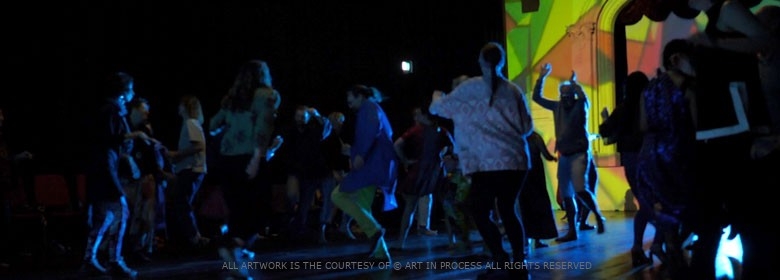
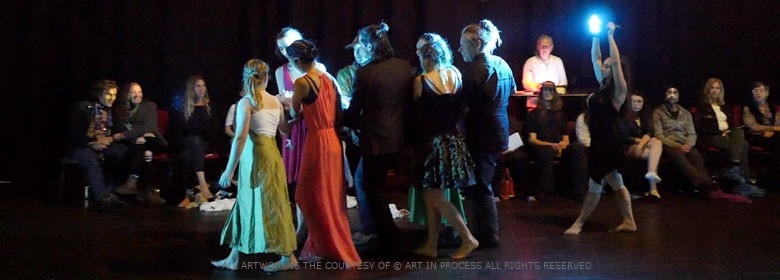
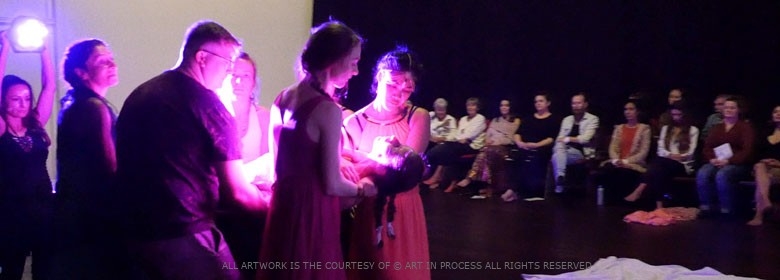
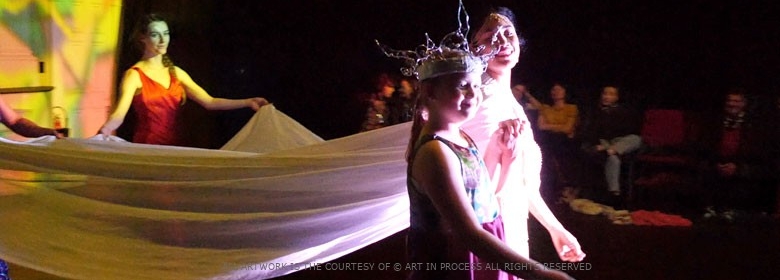
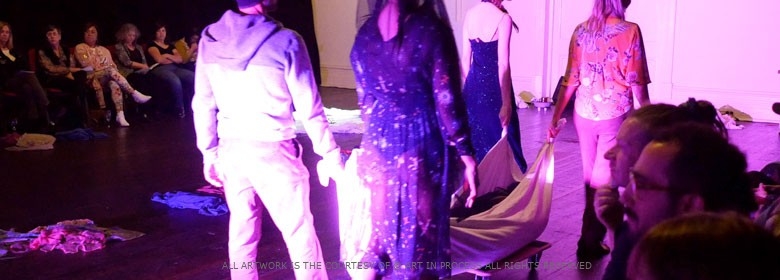
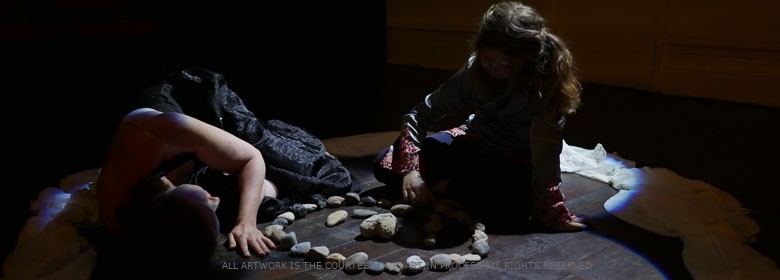
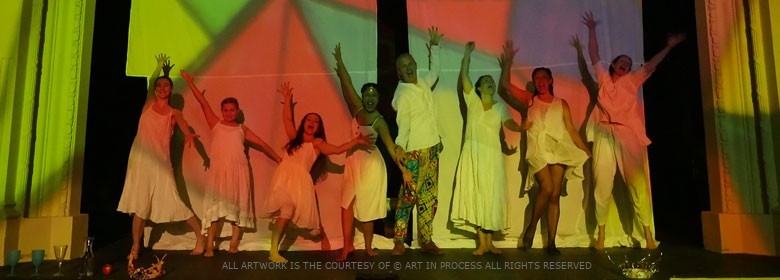
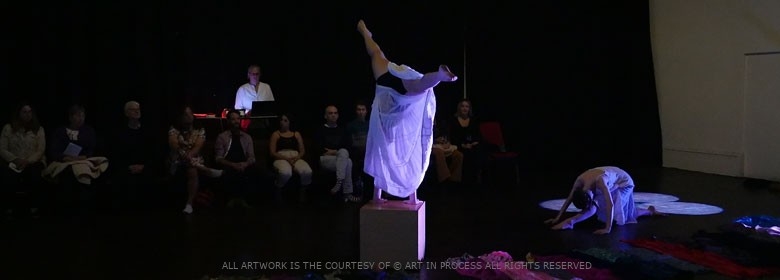

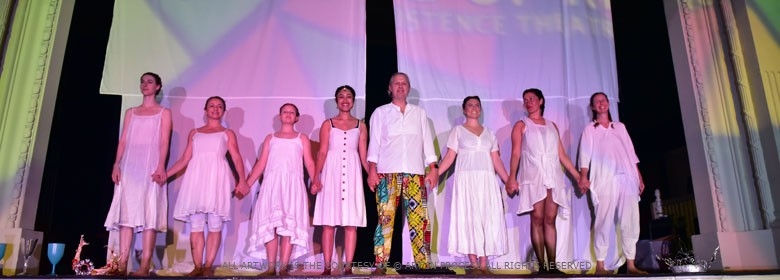
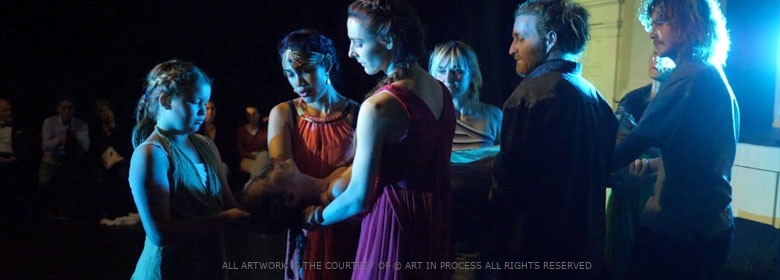
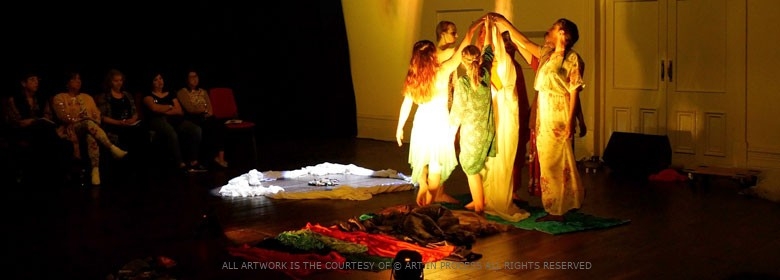
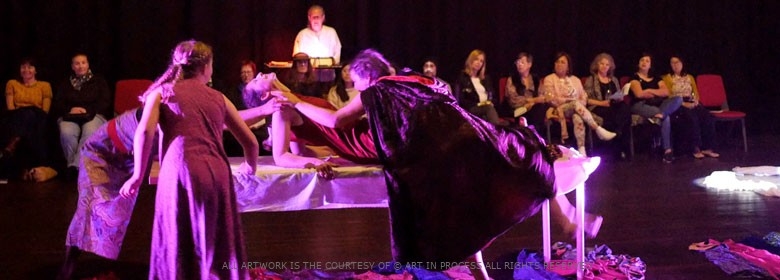
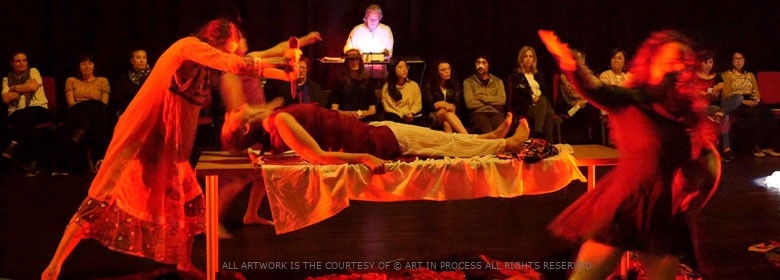
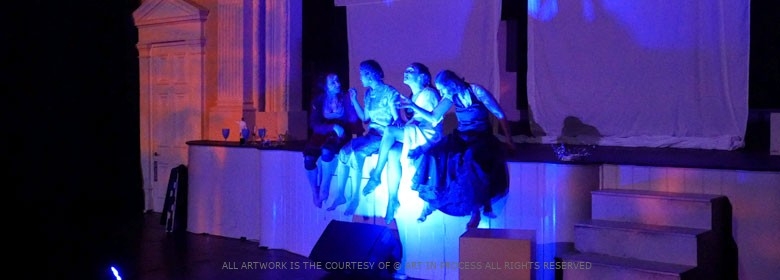
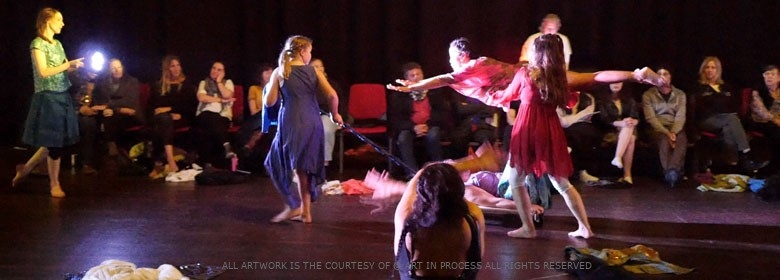

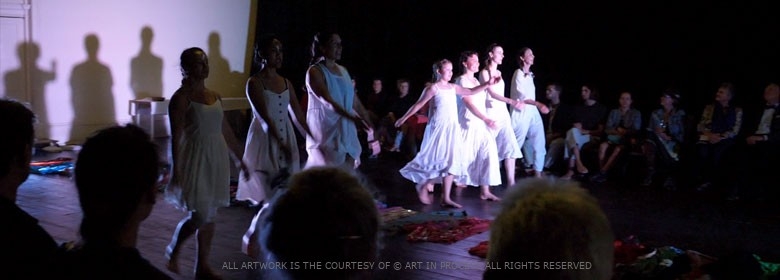
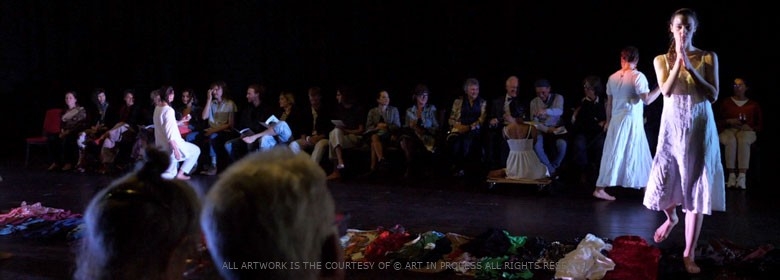
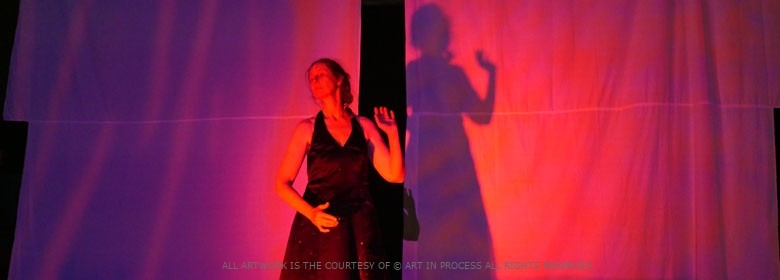
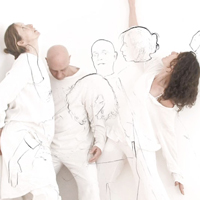 © EXISTENCE THEATRE ENSEMBLE
© EXISTENCE THEATRE ENSEMBLE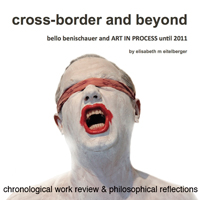 MONOGRAPH – in progress
MONOGRAPH – in progress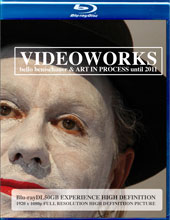 VIDEOWORKS BLU-RAY DL50GB
VIDEOWORKS BLU-RAY DL50GB